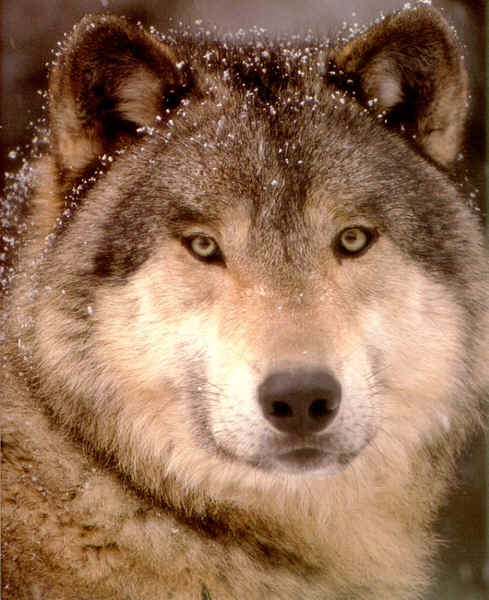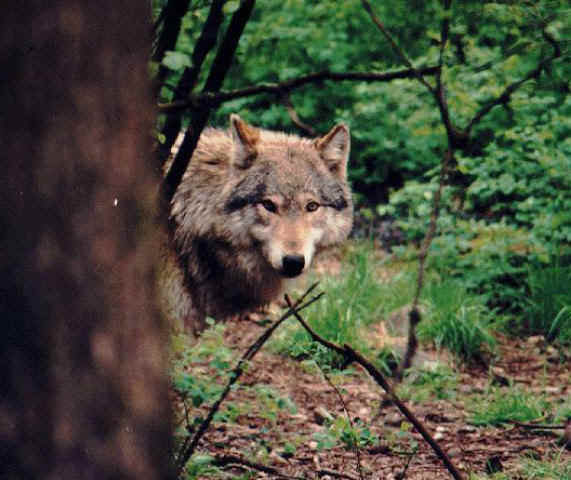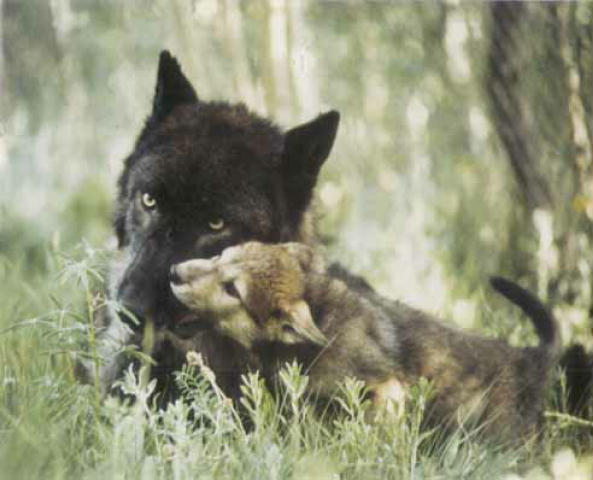

Communication And Behavior of Wolf
Communication
For cooperation to exist between any group of animals, some type or form of communication is necessary. Among wolves, communication is a highly developed skill. Without this skill, constant and clear communication between pack members would not be possible. Like humans, wolves use three main avenues of communication: olfactory (scent), postural (body language) and vocal.
Olfactory (Scent)
Olfactory communication among wolves consists primarily of scent marking. Scent marking is used to clearly mark the boundaries of territories, to claim and defend that territory from other packs, to mark food ownership and to act as a sort of road map for the pack itself. Because wolves have scent glands between their toes, they leave their personal signature wherever they walk. Urination is the most common form of scent marking for wolves.

Postural (Body Language)
A great deal of the communication among wolf pack members involves body language. Within a pack of wolves, specialized behaviors and postures have evolved that help to reduce the aggression between individual animals. This body language helps the pack live together and function as a harmonious unit. Position of the ears, tail, and lips are important in wolf communication.
Facial expressions are among the most obvious visual ways in which wolves express emotions. Generally, bared teeth with ears erect and pointed forward indicate a threat by dominant wolves. A relaxed but alert wolf or a dominant-aggressive wolf carries his ears up; a submissive or fearful wolf pins them back against the skull.
A wolf ready to fight curls his lips back fully, bares his teeth, stares intently, and raises his hackles. He may growl or not. Submissive wolves avoid eye contact with dominant members of the pack and may turn away from their betters. Conversely, closed mouths, slit like eyes and ears pulled back and held close to the head indicate subordinate behavior.
Wolves also use tail positions to communicate emotion. Threatening wolves hold their tails high, almost perpendicular, while submissive wolves lower themselves before dominant pack members, tails tucked between their legs.

Vocal
Vocal communication among wolves consists of howls, whines, growls and barks. Although all the functions of howling are not known, scientists think that one of the main reasons wolves howl is to assemble the pack. Another possible function of howling is to claim territory.
Some experts think that wolves can identify other wolves through their howls. Whines are used often at the den site and are used primarily by the adult female. They are thought to be sounds of affection.
Growling conveys aggressiveness and usually comes from dominant wolves posing a threat. Some experts think barking signifies alarm, while others think it is the call of the chase. It could also indicate any kind of excitement.
Wolf Eyes
The eyes of the wolf are blue at birth and
change to a yellowish-amber color. They are careful when using their eyes toward
other pack members. They stare at each other only before combat or play.
Eyesight is a major part of communication in the wolf pack.
Their eyesight is attuned for hunting. Wolves' eyes are not good at seeing
things far away and motionless, but they are highly sensitive to movement.
"Wolves live in an ongoing state of high general awareness and
watchfulness, and notice and assess small details quickly, because this is
essential for survival." p. 30 The Sawtooth Wolves

Cooperation And Unity
Understanding and respecting each other's communication leads to cooperation. Cooperation allows wolf packs to bring down larger prey than individual wolves could do on their own, insures the care and feeding of the young and allows wolves to defend their common territory.
Unity in the pack is maintained by complex use of facial expressions and body language that establish relationships between individual wolves that benefit the pack. Alpha wolves may place their head or paw on the shoulders of subordinates or grasp the inferior's muzzle in his jaws in play, just a reminder that he is boss. Or he may stare at boisterous subordinates in a C. lupus version of "Knock it off!"
Behavior
Many inferior wolves grovel to their superiors, mimicking the cub behavior of soliciting food by licking at the muzzle of the dominant animal. Sometimes, they lie on the ground and expose their bellies to the alpha wolf, and they may urinate to further state their acknowledgement that the alpha is truly the top wolf.

With the cubs, however, all bets are off. All adults accept the attentions, including the sharp teeth, of the cubs. The youngsters are allowed to practice adult behaviors with forbearance, although a particularly painful nip might be followed by a big paw pinning a hapless cub to the ground. Mother may grab a cub by the scruff of the neck and shake him for wandering off, or she may cuff several cubs that refuse to stop roughhousing, but these are manifestations of tough love, designed to keep the cubs safe and teach them manners.
The purpose of this social order is to increase hunting prowess and ensure the survival of the pack and therefore the species. Wolves cooperate when they hunt. In some cases, a couple of wolves will watch over the potential prey animal while the rest of the pack relaxes and plays. Then, when the hunt resumes, some wolves may leave the pack and circle ahead of the moose or elk, ready to ambush it. Sometimes wolves encircle a prey animal floundering in deep snow and simply wait for it to tire and collapse.

Wolves are good parents. The father brings food to the mother when the cubs are nursing. When the cubs get older both parents and other pack members help feed the cubs by regurgitating food for the young. When both parents go off hunting another pack member baby-sit. They will play for hours until the parents are back. Play is not only for the young, all ages engage in play. Wolves are very curious animals, so any thing they find could become a toy: wolf tails, bones, branches, rocks, the hide of last nights dinner, and many other strange objects. Adults will play with cubs and other adults, two or more adults will wrestle and chase each other for a long way from the others.
Wolves treat people the same way they would treat another wolf. This is why
it could be dangerous to people who don't know the wolf ways: language,
behavior, instincts and how they think. A wolf will bite a person if it feels
threatened and can't run, like when cornered, it's safer to let him have the
space he needs. Wolves are not afraid of people they are wary of us, that's why
it is not very likely to see on in the wild.
![]()
There is a tendency to judge their behavior as cruel or as gentle and loving, but wolves are simply animals that are equipped to survive in a harsh environment. Ascribing human emotions or characteristics to their behavior is inappropriate. To search for vestiges of that behavior in their descendants and attempt to comprehend it can enhance understanding of wolves and of the dogs that share man's home and hearth.
Introduction
[ What is A Wolf ? ] [ Myth And Legend of The Wolf ] [ Physiology of The Wolf ] [ Communication And Behavior of The Wolf ]
[ Family and Social Structure of The Wolf ] [ Hunting And Selection of Prey ] [ The Wolf Today ]
Poems
[ The Lone She-Wolf ] [ Fight of The Midnight Wolf ] [ The Spirit of The Wolf ] [ The Spirituality of Silent Wolf ]
[ The Lady of The Wolves ] [ The Wolf ]
Miscellaneous
[ Did You Know ? ] [ The Language of Wolves ] [ Wolves - Worldwide ] [ Questions And Answers About Wolves ]
Guest Book
[ Special Dedication ] [ Sign My Guest Book / Feedback ] [ View My Guest Book ] [ e-mail Me ]
Best view in IE5. Pentium II. True color (24 bits). Resolution 640 x 480